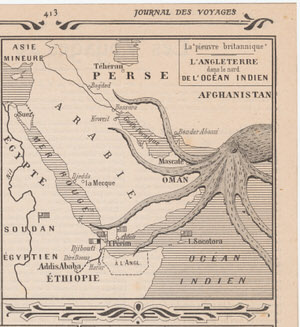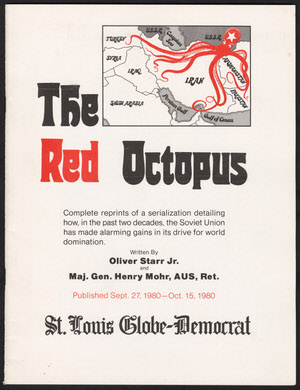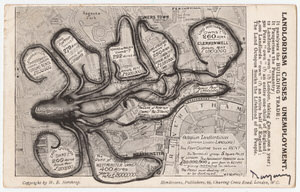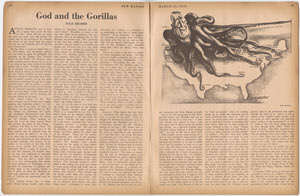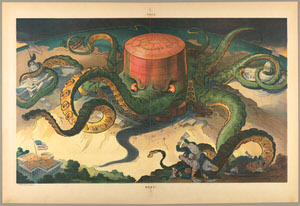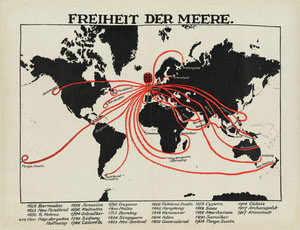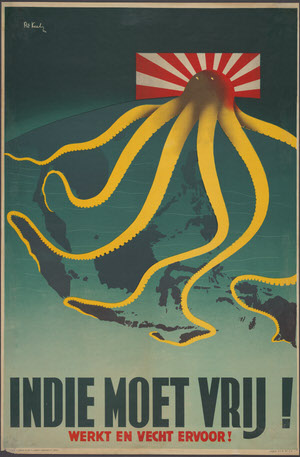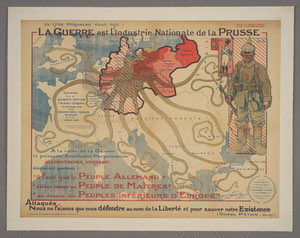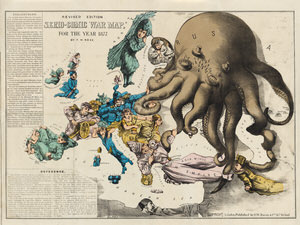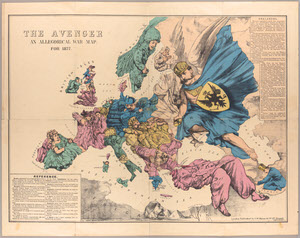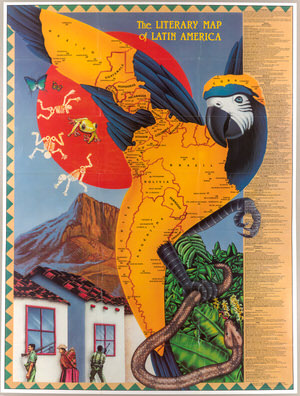Metaphor and Symbolism
A persuasive map has two important aspects: the message or subject of the map, and the techniques it employs, such as the use of allegory, symbols, or satire. Satirical and pictorial mapping combine illustrations and text with cartographic elements to convey social, economic, or political commentary.
The octopus is a persistent trope in persuasive cartography. With its many limbs capable of reaching in all directions, the animal has been employed repeatedly as a symbol for financial greed or a pernicious grab for power and territory. Its prevalence in 19th and 20th century maps suggests the persistence of the octopus as a means to evoke a sense of fear and foreboding in viewers with its all-consuming arms.
Many maps that use the octopus motif relate to imperialism and war. An 1877 map published in the midst of the Russo-Turkish War presents Russia as a monstrous creature grasping at land in all directions—reaching towards countries that are represented as threatened people. A French poster from 1917 depicts the growth in German armies over two centuries and Germany’s territorial expansion, while a 1918 German map argues that the British Empire threatens the freedom of the seas. But the octopus symbol does not appear exclusively in the context of wartime. It’s also used to present social and political arguments, such as denouncements of monopolistic corporations, “Landlordism” in London, mail order retail operations, and even a “reactionary” journalist.
“La ‘Pieuvre Britannique’ - L’Angleterre dans le nord de l’Ocean Indien.” [The British Octopus - England in the North Indian Ocean]. Journal des Voyages - Aventures de Terre et de Mer. Paris: Librairie Illustree, 1905.
Gift of PJ Mode.
This map from a French publication shows the aggressive reach of the British Imperial “octopus” on the Arabian peninsula and the horn of Africa in 1905.
Henry Mohr and Oliver Starr. “The Red Octopus.” St. Louis Globe-Democrat. September 27, 1980 - October 15, 1980.
Gift of PJ Mode.
The map illustrating this series of articles uses the octopus metaphor to describe the Soviet Union’s ambitions for world domination.
William Bellinger Northrop. Landlordism Causes Unemployment. Hendersons Publishers, London, 1909.
On loan from the Collection of PJ Mode.
This map uses the octopus trope to draw attention to the gap between the richest and the poorest citizens of London, showing how vast areas of the city were owned and controlled by wealthy and powerful aristocratic landlords. The text on the side states that “Landlordism” causes unemployment, paralyzes the building trade and “Pauperizes the Peasantry.” William Northrop was an American free-lance journalist and frequent contributor to British magazines who often targeted the inequalities of British wealth in his writing.
Scott Johnston, artist. “God and the Gorillas.” In: Kramer, Dale Kramer, “God and the Gorillas,” New Masses, March 24, 1936.
Gift of PJ Mode.
In this article from New Masses magazine, the influential and prolific newspaper columnist Arthur Brisbane is caricatured as a giant octopus, with arms reaching out to strangle cities from Seattle, Los Angeles and San Antonio to Washington and Boston.
Joseph Ferdinand Keppler. “Next!”Puck Magazine, September 7, 1904.
On loan from the Collection of PJ Mode.
This cartoon map, published eight weeks before the U.S. presidential election of 1904, depicts the Standard Oil Company as a great octopus spread out across the country, strangling state capitals and the Congress, and now reaching out “Next” in an effort to seize the White House. Theodore Roosevelt, having established his credentials in fighting monopolies, won reelection in a landslide, and in November 1906, his administration brought a massive antitrust suit against Standard Oil under the Sherman Act of 1890. The government won in the trial court, and in May 1911, the Supreme Court upheld the trial court’s decision and ordered Standard Oil dissolved.
Freiheit der Meere [Freedom of the Seas]. [Germany, late 1917-1918.]
Gift of PJ Mode.
This German poster depicts Britain as an octopus threatening the “Freedom of the Seas.” Its many arms reach out to some 27 places allegedly colonized or attacked by the Empire. The poster represents German efforts to gain leverage in the eventual World War I peace negotiations.
Patrick Cokayne Keely. Indie Moet Vrij! Werkt en Vecht Ervoor! [The Indies Must Be Free! Work and Fight for It!]. Regerings Voorlichtings Dienst, publisher, and James Haworth & Brother Ltd., printer, 1944.
On loan from the Collection of PJ Mode.
This World War II poster portrays the Japanese Empire as an octopus whose arms reach out to control the Dutch East Indies. It was likely printed in anticipation of an imminent Allied liberation, but the Dutch desire to reclaim their colonial territory was countered by Indonesia’s efforts to gain its independence, which they declared within five days of the Japanese surrender.
Maurice Neumont. La Guerre est l’Industrie Nationale de la Prussia [War is the National Industry of Prussia]. P J Gallais et Cie, Edit., printer, and La Conference au Village contre la Propagande Ennemie en France, 1917.
On loan from the Collection of PJ Mode.
This French propaganda poster from 1917 is captioned with an 18th century quote: “Even in 1788, Mirabeau was saying that War is the National Industry of Prussia.” Figures at the upper right chart the growth in German armies over two centuries, and color codes show the country’s territorial expansion. Dramatically, Germany is shown as an octopus with arms extending not only west to France, England, Spain and Italy, but to the Balkans and Greece, Turkey and Asia Minor, Romania and Russia.
Frederick W. Rose. Serio-Comic War Map for the Year 1877. George Washington Bacon & Co., 1877.
On loan from the Collection of PJ Mode.
The octopus is a persistent trope in persuasive cartography. It first appeared in this satirical map in March 1877, two months after Russia attacked the Ottoman Empire in response to the Turkish massacre of Christian Bulgarians. It reflects the political views of the pro-Turkish Russophobe Tories in Britain.
The Avenger: An Allegorical War Map for 1877. George Washington Bacon & Co., 1877.
Gift of PJ Mode.
This map, produced by the same company as the Serio-Comic War Map, represents the opposing viewpoint held by the anti-Turkish Russophile Liberals in the British government concerning the Russo-Turkish War of 1877-78. Here Russia is represented as an allegorical figure of Progress who is seen punishing Turkey for the massacre of Christian Bulgarians in April 1876.
Mike Cressy. The Literary Map of Latin America. Molly Maguire, designer, and Aaron Blake, publisher, 1988.
Gift of PJ Mode.
This promotional map-brochure celebrates the cultures of multiple countries, states or regions in Mexico, Central and South America and the Caribbean by offering an historical overview of their literary contributions. An accompanying list features the names of novelists and poets, many of them Nobel-prize winners.
